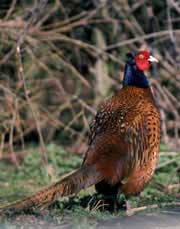Lovelorn pheasants spread ticks

Single, tick-ridden pheasants are more mobile. <br>© David Kjaer/BBC wild <br>
Disinfecting male birds might not help curb Lyme disease.
Treating male pheasants against the ticks that carry Lyme disease might do more harm than good. Tick-free males are more sexually attractive, so untreated males are forced to roam farther in search of mates, possibly spreading ticks as they go.
A blood-dwelling bacterium called Borrelia causes Lyme disease, famed for its arthritic symptoms. Ticks spread the bug when they bite rodents, birds, deer and humans.
Pheasants carry the tick and the bacterium Borrelia burgdorferi garinii. Once thought to cause disease only in birds, “there’s increasing evidence that garinii is found in humans”, says Andrew Hoodless, of the UK Game Conservancy Trust. This bacterium can cause brain inflammation in severe cases.
Lyme disease is on the rise in Europe and North America – human cases have more than doubled in the United Kingdom in the past 15 years. In parts of the United States, “people fear nature, in part because of exposure to Lyme disease”, says Richard Ostfeld, who studies the disease at the Institute of Ecosystem Studies, Millbrook, New York.
In Britain these common birds frequently come into contact with gamekeepers and hunters. Every July, about 20 million farm-reared pheasants are released into the British countryside as fodder for the winter shooting season, which ends today, February 1st.
Hoodless and his colleagues found that pheasants’ ticks don’t pose a direct threat to people. The birds tend to harbour young ticks unlikely to bite us. “There’s no risk to humans from handling dead pheasants,” says Hoodless.
But as tick nurseries, pheasants could be crucial to the spread of Lyme disease. Control measures could be justified in woodlands with a combination of pheasants, deer – which host adult ticks – and good public access, warns Hoodless.
Ticking off
But it’s “probably unwise” to disinfect male pheasants, says Hoodless. Males treated with a tick-killing chemical had larger wattles – the red fleshy appendage on the head, his team found.
This makes them irresistible to the opposite sex, with top males attracting a harem of three or more females. Sexual fulfilment quelled males’ wanderlust – they had smaller territories and tended to move around less.
But if males miss out on treatment – a distinct possibility in the wild – they are less attractive. Unable to compete with their tick-free peers they wander in search of love, the team found.
“It shows the subtle effect of ticks on their hosts,” says Ostfeld. “Treating some males might induce others to roam more widely”, spreading ticks as they go.
Curing females might be a better option. Hoodless’ unpublished results show that tick infestations reduce females’ reproductive output. Estate managers are keen to establish self-sustaining wild populations because “they are perceived to give better shooting”, Hoodless says.
References
- Hoodless, A. N. Kurtenbach, K. Nuttall, P. A. & Randolph, S. E. The impact of ticks on pheasant territoriality. Oikos, 96, 245 – 250, (2002).
Media Contact
All latest news from the category: Life Sciences and Chemistry
Articles and reports from the Life Sciences and chemistry area deal with applied and basic research into modern biology, chemistry and human medicine.
Valuable information can be found on a range of life sciences fields including bacteriology, biochemistry, bionics, bioinformatics, biophysics, biotechnology, genetics, geobotany, human biology, marine biology, microbiology, molecular biology, cellular biology, zoology, bioinorganic chemistry, microchemistry and environmental chemistry.
Newest articles

NASA: Mystery of life’s handedness deepens
The mystery of why life uses molecules with specific orientations has deepened with a NASA-funded discovery that RNA — a key molecule thought to have potentially held the instructions for…

What are the effects of historic lithium mining on water quality?
Study reveals low levels of common contaminants but high levels of other elements in waters associated with an abandoned lithium mine. Lithium ore and mining waste from a historic lithium…

Quantum-inspired design boosts efficiency of heat-to-electricity conversion
Rice engineers take unconventional route to improving thermophotovoltaic systems. Researchers at Rice University have found a new way to improve a key element of thermophotovoltaic (TPV) systems, which convert heat…



